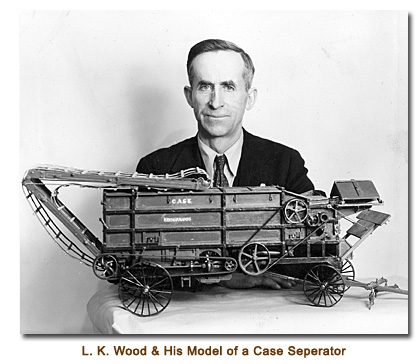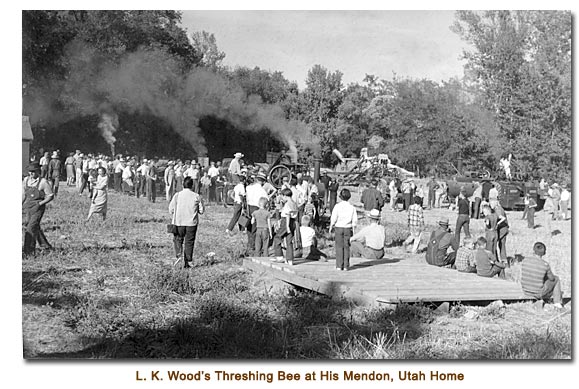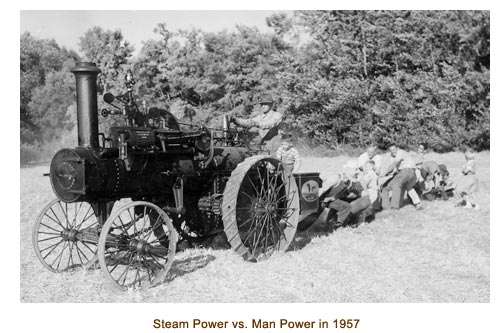L. K. Wood & The Mendon Threshing Bee—
Linden Kimble Wood was born, lived and died right here in Mendon, Utah. No one in town ever called him Linden Kimble, except perhaph his mother, everyone simply refered to him as L. K. or L. K. Wood. Many folks never even knew what those two initials stood for. But what can I say about him that has not been told and retold by so many before? If you know anything about threshing, you know that L. K. Wood and steam powered threshing are one and the same. He is one of the most remarkable men that Mendon has ever produced. He loved steam and steam engines. He had the skill and knowledge to build scale models of them as in this photograph of him above. Not only were they accurate scale models, but also they would and could, fire and make steam. Even the little tiny ones … I remember as a child a working model that was housed and or displayed in the Utah, State Capitol building, on a thick glass shelf. It was about a foot in length or so; I think another one went back east, perhaps to the Smithsonian for display as well. They were in their time and still are a major marvel today; he was a marvel of a man as well. The L. K. Wood Threshing Bee was bigger than Mendon’s May Day, during the time that he put on the major demonstration of steam threshing power. L. K. Wood simply was and is, Mendon’s own true original genius.
I was six or seven when I first got to go and ride in the side coal bucket of one of his steam engines, driven by my older cousin, Glena Buist Markey. I would be “dropped” into this right or left hand coal bucket that was part of the steam engine, but low enough still, so that I could still see over… and I got to tool about L. K. Wood’s back yard, the home of the, L. K. Wood Threshing Bee. He had horse threshing as well on display, they would start off the morning with a miniature, horse powered device he had built, that was in turn connected to a separator or thresher. Four or more teams would go round and round as in days of old and a jackshaft would transfer this ture horsepower, to a restored thresher. Later in the day, around noon, they would sometimes go out and bind up some wheat, this is a machine pulled by work horses that would cut and gather the grain crop into bundles, complete with a little string knot to complete the assembly of “binding.” From there they would toss the bundles onto a wagon and move this when full, up to the separator or thresher. Here a huge, full sized, restored steam engine would harness itself to the thresher, by means of a long canvas belt, held together with iron staples. This belt always had a “flip or twist” in the middle, so as to run on one side of the belt on the thresher and the other on the steam engine. This simple twist of the belt also kept the belt in place once the two machines were aligned and true. The steam engine was then blocked into place and with a double toot of the shrill whistle; the large drive wheel was engaged. This transfer of power would start the thresher cylinder, fans, sifters and shakers into a whir of heavenly motion.
What a racket all of this would make… but no one cared, least of all I, for the magic of this symphony of moving mechanical parts, fans, puffs of black smoke and spits of hot steam, as the first bundles of grain from the wagon were pitched on to the lead conveyor and made their way to the claws of the spinning cylinder, this resistance would in turn make the driving power, of the steam engine lug for a moment as the engineer would throttle up the power, to overcome the resistance of the wheat shafts, in their tight bundles. Black smoke would yield to a gray transparent hiss as the two machines became one. A nod of the head by one of the two or more men assigned to pitch or fuel the thresher with pitchfork in hand, would in turn bring a frenzy of activity as the steam engine, engineer brought the RPM of the drive wheel to that required by the thresher. The next thing you knew there was grain pouring out of an elevator and into a gunnysack. One man would hold them up to this “spout” and another would sew or tie up the sack. At near the same time, the rear of the thresher would spring to life, blowing out the spent straw shaft and beards, hulls and other waste from the separator operation. A huge straw stack would be created behind the machine, a place sure to draw the kids… who would scratch and itch for the rest of the day. What fun was this! Every child in Mendon, dreams come true. Steam, smoke and action from 10:30 in the morning until 6:00 p.m. one Saturday each fall come August.
I suppose in between setups, they would have other demonstrations, such as the most powerful and modern tractor in all of the Mendon, Utah area vs. one of L. K. Woods’s spare steam engines — they always lost. I figure that the weight of the steam engine alone most likely could stall the rubbered tired, diesel fuel powered farm tractors. I do not think in the whole time of the threshing bee, that they did this tug-of-war, L. K. Wood lost. He had a steam-powered calliope that they would play as well. He used to drive this steam powered musical organ up and down the streets of Mendon, in days past, to wake up the town for important events, at times even for May Day. L. K. Wood was a master machinist, his shop buildings were open to all to view projects he might be building or repairs for a new steam engine to debut at next years Threshing Bee. It seems that he had at least three “'real” steam engines and a bunch of scale models that were being driven round and about. His working scale threshers and steam power were something that I, nor many others, will ever forget. Plus he was just such a nice man.
L. K. Wood liked to take his little Ol’ Betsy up to the top of the road at Cold Water, above Mendon. Just for the fun of it. He often would call one friend or another and ask if they would like to take a ride to Cold Water with him. This is something for sure we will never see again…
![]()
